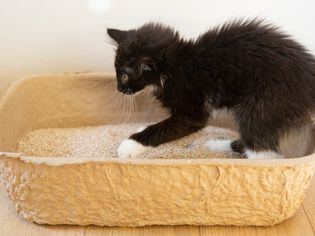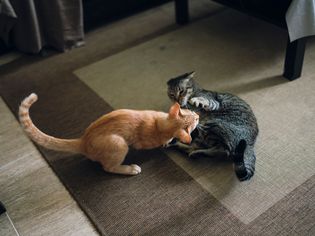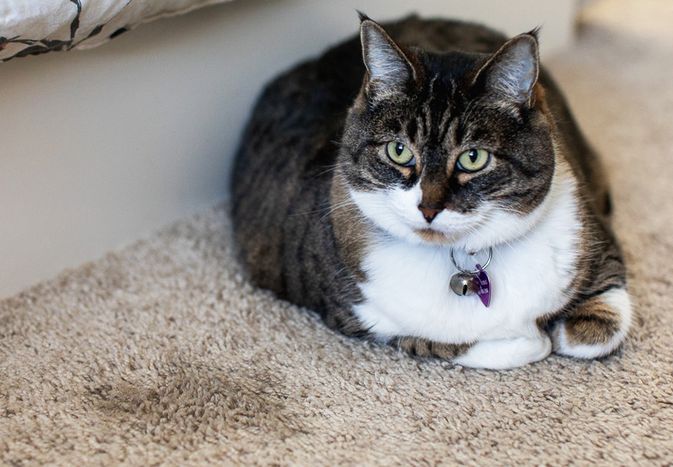When you bring home a new kitten, one of the very first things you will need to teach them is how to use the litter box. Proper litter box training early on will help your kitten develop healthy habits for life.
Your new kitten may or may not already know how to use a litter box. It all depends on how it was raised by its mother. Kittens learn most of their behaviors from their mother over the first six weeks of their lives. If the mother uses a litter box, then the kitten will likely learn this before being adopted into a new home. Howevers, if the kitten was raised outdoors or was separated from the mother too early, it might have no knowledge of litter boxes or even proper elimination habits. This is where you come in and begin litter box training.
Choosing a Litter Box
Your kitten needs an easily accessible litter box, so choose something with low sides that it can easily step into. It should be big enough for the kitten to turn around and eliminate in more than one spot as well. A basic small plastic litter box can work well. However, you may wish to start with something like an old baking pan or a shirt box with a liner, especially if your kitten is very tiny.
Covered litter boxes and automatic litter boxes may or may not work for your kitten. In the beginning, it may be best to use an open box so you can observe your kitten in it. Once your kitten learns to use the box, you may wish to try covering one box and leaving another open so you can learn if your cat has a preference. Some cats prefer the privacy of a covered box, while others dislike the closed-in feeling.
If you have multiple cats, a good rule of thumb is to have one litter box per cat, plus one extra. It's still a good idea to have two litter boxes if your kitten is the only cat in your home. In a multi-story home, put a litter box on each level.
Types of Litter
The type of litter you choose can make a big difference in how well your kitten takes to litter box training. The texture of scoopable litter is generally preferred by cats over the larger non-scoopable clay style. Unscented litter is best because perfumes can overwhelm your kitten's sensitive olfactory system.
Be aware that some kittens will eat cat litter when they are first introduced to it. This can lead to dangerous gastrointestinal problems. For this reason, you may wish to choose corn- or wheat-based scoopable litter.
You may also wish to get a mat to place outside the box to catch litter particles as kitty steps out. Make sure you choose something that will feel soft and comfortable on your cat's paws. Rough or spiky surfaces are likely to deter your cat from entering the litter box.
Creating A Safe and Clean Environment
The litter box should be placed in a private yet accessible area of your home. Avoid cramped spaces like under cabinets or in small closets. Make sure the box is not next to a loud appliance or something else that makes scary noises.
The litter box should not be placed near your kitten's food and water dishes, nor should it be too close to your kitten's favorite sleeping spots. Kittens and cats naturally prefer not to eliminate near their food and beds.
Maintain a clean litter box and keep the surrounding area as clean as possible. Scoop the litter box once or twice a day. Immediately clean up any accidents made outside the box and sweep up stray litter pieces regularly.
A clean, neutral-smelling litter box is much more inviting to cats and kittens. A dirty litter box can easily lead to unwanted elimination behaviors, like peeing on laundry or rugs.
Training Steps
The litter box area should be all set up before you bring your new kitten home. It is usually advised to start new kittens out in a "transition room" that is safe, comfortable, and keeps the kitten isolated from other areas of the home. This can also really help with litter box training.
Set up the food and water on one side of the room and put the litter box as far away as possible. Keep your kitten in the room for the first several days to weeks until it seems comfortable in the environment. Once you let kitty out to explore the rest of your home, it's best to return it to this room when you are not home.
Right after your kitten eats or drinks, place it in the litter box and do this each time. You may even try scratching at the litter to show the kitten what to do. If you see your kitten sniffing or scratching the ground, place it in the litter box.
If your kitten uses the litter box, offer praise with petting or even a toy or treat. First, let the kitten explore the area and make its own way out of the litterbox. Don't scoop up the area right away; let the scent remain as a reminder to your kitten later.
Problems and Proofing Behavior
Most kittens will learn to use the litter box fairly quickly. It may take longer for some kittens, so try to be patient. If your kitten has one or two specific areas in the house where it likes to eliminate, move the litter boxes to these areas. If this does not work, try changing the litter box or the cat litter brand or type.
When considering litter boxes, try to put yourself in your cat's position. Is there something in the area that is frightening or distracting? Perhaps there is a sight or sound that makes your cat want to avoid the area. Maybe the litter box has a strong plastic smell to it. Perhaps the litter does not feel good on the paws or has an odor kitty dislikes. You may need to make several small changes before your kitten will accept the litter box.
Remember, never punish your cat for accidents. Be consistent about moving the kitten to the litter box if you catch it in the middle of an accident. Try not to get angry or frustrated. Stress in the environment is the main cause of behavioral litter box issues. This means you may need to assess your kitten's environment. Are there other pets in the home causing stress? Is your kitten acting anxious or restless? Perhaps it needs more exercise or vertical space.
If you continue to have trouble, talk to your veterinarian, who can rule out health issues that might be getting in the way of litter box training and offer training suggestions.










Comments on " Training Your Kitten to Use the Litter Box" :